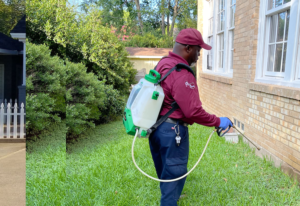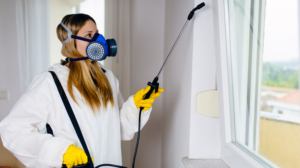Exterminator Bakersfield helps prevent pest infestations. They control pests using various techniques, including sprays and traps, and keep detailed records of their work.
Exterminators offer temporary support and relief to homeowners dealing with pests such as termites, cockroaches, ants, and bed bugs. They also provide ongoing maintenance to ensure that pests do not return.

Exterminators work in a variety of environments, including residential and commercial settings. They control pest infestations and educate their customers on preventing future problems. This includes implementing exclusion techniques, traps, and chemical treatments. Exterminators may also offer recommendations to help clients avoid pests, such as improving sanitation or sealing cracks and gaps in the home or office.
Working as an exterminator can be a challenging and rewarding job. In addition to the physical demands of the job, it requires a great deal of travel to provide services to clients. This can be difficult for individuals with families or other responsibilities and can lead to additional stress. In addition, the nature of the work can be dangerous, requiring workers to wear protective equipment such as goggles and gloves when handling chemicals.
The average salary for an exterminator is $52,680. Those with more experience can expect to earn higher salaries. It is important to note that most exterminators work full time, and many work evenings and weekends. In addition, this type of work can be very weather-dependent.
Exterminators are highly specialised professionals. They usually have years of training and are familiar with the latest pest control methods. They are also experienced in the use of insecticides, rodenticides, and baits. They also know how to properly use mechanical devices such as pheromone traps and insect growth regulators. In addition, they have excellent verbal and written communication skills.
A typical day as an exterminator includes talking to a client and inspecting the premises for signs of pests. They will examine both the interior and exterior of the building, looking for places where the pests might be hiding. After they have a clear understanding of the problem, they will come up with a plan to eradicate it. This is often done through a series of treatment plans, which may involve the use of poisonous chemicals. Some exterminators also use environmentally friendly solutions, which are safer for families and pets. In addition, they can help establish long-term prevention methods. This can include eliminating food sources, sealing entry points, and using traps and barriers.
Training Requirements
Aspiring exterminators must acquire formal education and training before working in the field. This includes taking courses on pest identification and control, as well as passing state-administered exams. The training process may vary from one region to another, with some states requiring a period of apprenticeship or a postsecondary degree. Some also offer certifications or credentials that can help with career advancement.
A pest problem can be complex and unique, so each exterminator needs to be prepared to analyze each situation and determine the best course of action for eliminating the pests. This may involve minimizing risks to human health and the environment, as well as communicating clearly with clients. For example, if an exterminator encounters a bed bug infestation in a hotel room, they must critically examine the situation and determine how to eliminate the pests while minimizing the risk of spreading the infestation to other rooms.
Those seeking to work as an exterminator should also have excellent customer service skills. This is especially important if the job involves working in customer homes or businesses. Exterminators must be able to communicate effectively with their customers in order to understand and address their pest problems, as well as provide them with information about treatment options and costs. Moreover, customer service skills are essential for establishing trust with clients.
While many people dream of becoming an exterminator, not everyone is cut out for the profession. It is challenging to work in confined spaces and deal with distressed clients, so it’s important to consider the physical and emotional demands of the job before making a decision to pursue this career path. Those who decide to become an exterminator must also familiarize themselves with the specific certification and licensing requirements in their state or region, as these can vary significantly.
Exterminators must also stay up-to-date with the latest technologies and methods in the field. This will help them keep up with the latest trends and ensure that they are using the most effective strategies in their work. In addition, they should be willing to participate in continuing education programs. This will allow them to keep up with new developments in the industry, such as eco-friendly pest control methods and new regulatory requirements.
Job Duties
An exterminator is a professional that works to eliminate pests from homes and businesses. They use a variety of methods, including traps, baits, and chemical sprays. They also keep accurate records of treatments and results. They may also be responsible for cleaning contaminated areas and ensuring compliance with safety regulations. In addition, they may need to monitor or maintain traps and other equipment.
Pests can cause serious damage to a home or business. They are also a health threat, as they can spread germs and diseases. For example, mosquitoes can cause malaria and encephalitis, while fleas can carry the plague or Lyme disease. In addition, rodents can cause structural damage and chew through wiring, causing fire hazards. Therefore, it is important to hire a qualified exterminator to eliminate the pests before they cause further damage.
A good exterminator should have a strong knowledge of pest control and entomology. They should also be able to analyze the situation and recommend the best solution. They must also have the ability to work as a member of a team. In addition, they must be able to communicate with customers and understand their needs. They should also be able to identify potential sources of infestation and prevent pests from returning.
When hiring an exterminator, it is important to make sure that they are licensed and insured. In addition, you should also make sure that they have experience in the industry. The best exterminators will be able to provide you with an estimate of the cost and time frame for the job. They will also be able to answer any questions you may have about the process.
Many people associate the job of an exterminator with a person carrying sprays and traps, ready to kill bugs. However, this is just one aspect of the job. Exterminators must also conduct inspections and educate their customers on prevention. They must be able to deal with a variety of pests, from ants to bedbugs to mice and more. Depending on the type of pest, they will need to use different treatment methods.
Salary
An exterminator’s salary can vary greatly depending on several factors, including education level, job experience, and specialization. In addition, salary levels may be higher in areas with more intense pest infestation problems. Other important qualifications include strong customer service skills, the ability to perform thorough inspections of homes and businesses, and knowledge of all safety regulations.
A career as an exterminator can be a lucrative and rewarding choice for those with the right training and experience. Those with an advanced degree, such as a bachelor’s degree in entomology, can also earn higher salaries. However, the most important factor in determining an exterminator’s salary is his or her experience level. Experienced exterminators can expect to make significantly more money than those just starting out.
Another factor that can influence the salary of an exterminator is his or her location. In areas with dense populations or warmer climates, there is a greater need for pest control services. This can lead to higher demand and therefore higher salaries.
One of the main differences between an exterminator and a pest control service is that an exterminator typically uses methods that are more focused on killing the pests rather than treating the root causes of the problem. In contrast, a pest control company will focus on finding ways to prevent the recurrence of pest infestations through environmentally friendly and safe techniques.
A pest control company will often use less harmful chemicals than an exterminator, which can be a major selling point for those who are concerned about the impact of harsher chemicals on their home and family’s health. Additionally, a pest control service will almost always guarantee their work. This means that if the pest infestation reoccurs after treatment, they will return to fix the issue free of charge.
A professional pest control service will take the time to understand the nature of your pest infestation and develop a customized plan to solve it. This approach allows them to offer a comprehensive set of solutions that will prevent the pests from returning and will provide long-term results. In addition, a professional pest control service will be able to identify early signs of infestation, helping you avoid costly repairs and prevent your pest problem from getting out of hand.








